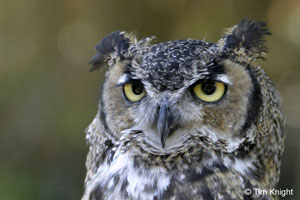
Home | About Us | Projects | Maps | Facts

Home | About Us | Projects | Maps | Facts

Great Horned Owl (Bubo virginianus) Description: One of the most distinctive looking and least likely to be misidentified of all owls is the Great Horned Owl. This is because of its large ear tufts, which give this owl a somewhat cat-like appearance. Some people even call the Great Horned Owl a "Cat Owl" because of its ears.
Calls:
The call is a deep hooting "hoo-h'HOO--hoo-hoo." Young make a loud, raspy screech. 
Range/Habitat: The Great Horned Owl is found all across the United States and Canada in large numbers. It is about 22 inches long, and has brown feathers with a white throat and light colored feathers inside its wings. Of course, as previously mentioned, it is most famous for its ear tufts or “horns.” Great Horned Owls can be found in a variety of habitats including cliff sides, deserts, forests and other wooded areas, and shrublands. Click the range map to learn more about the distribution of Great Horned Owls in California. Nesting: They make their nests in hollow trees, in nests abandoned by or taken from other birds such as hawks and crows, and sometimes in tree cavities previously used by squirrels. Great Horned Owls may also nest in caves, stumps, rock ledges, barns, and other man-made structures. They usually will not use the same tree to nest in two years in a row. A female owl will lay 2 or 3 eggs in the nest and will incubate them for 26 - 35 days, during which time the male will feed her. After the eggs hatch, both parents will feed the young, gathering an average of 300 grams of food per day. The young owls will leave the nest after about 4 - 5 weeks, and will fly well by about 9 weeks. The Great Horned Owl has a life span of at least 28 years in the wild.
Diet: Great Horned Owls spend most of their time hunting for prey, waiting in branches and flying silently to the ground to catch their prey. They hunt during both day and night, but can see better at night than in the day. Great Horned Owls are carnivores, typically eating small mammals such as mice, rabbits, woodchucks, rats, squirrels, and even skunks. They will also sometimes eat other birds such as ducks and hawks.
Animal silhouettes available to purchase » Photos: Karen Dvornich; Tim Knight; Natures Pics |